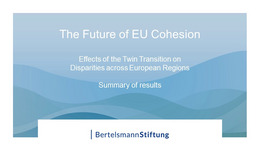The starting point of the study is an estimation of the potential for general economic growth. Regions in Eastern Europe, which have exhibited prolonged periods of growth in recent decades, have a worse outlook when it comes to their potential for future growth, as they have lower scores for key growth drivers such as high-skilled employment, investment or innovation. Together with Southern European regions, which already experienced stagnating economic development in the past, their future growth potential falls behind those of their counterparts in Western and Northern Europe.
In addition, regions are unevenly prepared for reaping the benefits or shouldering the costs of digitalising and greening and their economies. For example, regions with high levels of labour productivity, good internet access or high levels of business sophistication are poised to benefit more from a digitalised economy. Other regions are better prepared to decarbonise their industrial production, transport sector or housing stock. Some regions are well suited to tackle both transitions, and many are not particularly ready for either.
The study assesses how the twin transition may alter the prospects of future economic development. It finds that especially urban and metropolitan regions that are mostly specialised in knowledge-intensive services show high levels of readiness for the digital and green transition in addition to a high general growth potential. These regions will most likely pull ahead in the face of the twin transition. They include Lisbon, Berlin, Bratislava, Budapest, Warsaw, Prague, Stockholm and Cologne to name a few, but also regions around the Alpine area in Europe’s core.
The study also shows that particularly rural and agricultural regions in Spain, Greece, Southern Italy or Romania, but also mining regions in Poland or Slovakia have low levels of digital and green readiness on top of a low potential for general growth. These regions will therefore most likely fall further behind on the back of the twin transition.







